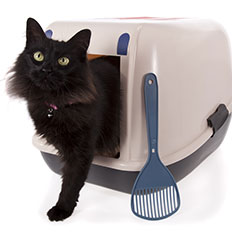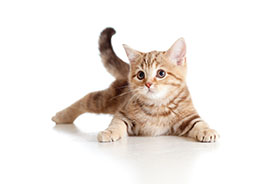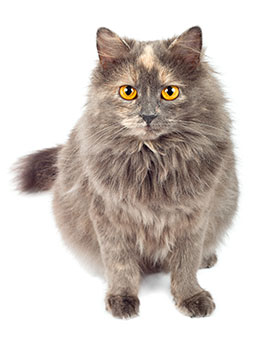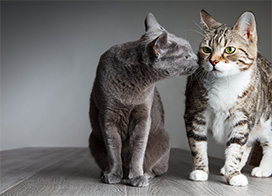Feline Lower Urinary Tract Disease
Lower urinary tract disease (LUTD) covers a range of disorders from mild to serious. The signs of LUTD are usually referred to as lower urinary tract signs, or LUTS.
LUTD includes abnormalities in the structure and function of the bladder and the urethra (see figure). Surveys suggest that is the number one reason cats visit veterinary practices.
Clinical Signs
The most common signs of LUTD include:
- Difficult or painful urination
- Increased frequency of urination
- Crying out while urinating
- Blood in the urine
- Inappropriate urination (that is, outside of the litter box)
-
Frequent licking of the genital region.
In cats, LUTS often have more than one cause and may be brought on by infections, inflammation, diet, and behavioral issues. Cats with urethral obstruction (see Common Causes of LUTS) will often show the above signs but will pass little or no urine and will become increasingly distressed. A urethral obstruction is an absolute emergency, requiring immediate veterinary treatment.
While cats of any age can show LUTS, it is most frequently seen in middle-aged, over-weight cats that get little exercise, use an indoor litter box, have restricted access outdoor environments, and drink less water. Male cats may be at an increased risk, and stressful environmental factors, including living in a multi-cat household and changes in routine, such as a move to a new home, may also increase the risk that a cat will develop LUTS.
Diagnosis
Because feline LUTS can have many causes (see below), their origin can be difficult to diagnose. Based on a cat’s clinical signs (symptoms), a veterinarian will likely perform a physical examination and a urinalysis (microscopic analysis of a urine sample) as part of the initial diagnostic plan. If the cause of the cat’s LUTS has not been identified with a urinalysis, you’re your vet may recommend other testing, including blood work, x-rays, abdominal ultrasound, and/or a urine culture.
Common causes of LUTS in cats
Some of the most common causes of LUTS include idiopathic cystitis, a painful bladder condition; urolithiasis (also called urinary stones), in which solid material forms in the urinary tract; and urethral obstruction, a blockage of the urinary tract.
Idiopathic Cystitis
Feline idiopathic cystitis (FIC) is the most common diagnosis in cats with LUTS (idiopathic means “of unknown cause”). FIC is a catchall term used to describe cases of LUTS in which all diagnostics fail to confirm the cat has another disease. Cats suffering from FIC make frequent attempts to urinate, probably as a result of bladder discomfort, and often are found to have blood in their urine. Signs of lower urinary tract disease in cats with FIC often resolve within a couple of weeks regardless of treatment, so most veterinarians treat the condition in order to prevent the signs from recurring.
Stress seems to be an important factor in the development of FIC. Possible sources of stress in a cat’s life may include environmental changes, changes in food schedule, and changes in the number of animals in the household. Environmental enrichment and modification can reduce stress and decrease the severity and frequency of FIC episodes. To reduce environmental stress, cats should be provided a safe, clean area in which to urinate, as well as opportunities to express natural predatory behavior. These opportunities may include climbing posts and toys that can be chased and caught.
Because changes in food can also result in recurrence of FIC in some cats, the cat’s diet and feeding schedule should remain consistent. Many pet food manufacturers market diets formulated for “urinary health.” While these foods may reduce the likelihood that cats with FIC will develop a urethral obstruction, there is no evidence that they have reduced the incidence of feline LUTS themselves.
Uroliths (Urinary Stones)
Another possible cause of LUTS in cats is urinary stones, or uroliths. These rock-hard collections of minerals that form in the urinary tract of cats can irritate or even obstruct the urinary bladder, the urethra, or both. Due to the anatomy of the male cat’s urinary tract, males are at increased risk of lower urinary tract obstruction by uroliths. X-rays or ultrasound are usually used to make a diagnosis of uroliths. The two most common stone types in cats are called struvite (composed of magnesium, phosphorus, and ammonia) and calcium oxalate. The treatment of a cat with urinary stones depends on the mineral composition of the stones, but surgical removal of stones is often required.
For cats with struvite uroliths, a veterinarian may prescribe a special stone-dissolving diet to eliminate the stones. If this treatment fails, surgical removal may be necessary. Struvite stones are becoming less common in cats, as most commercial feline diets are now formulated to reduce the likelihood of struvite formation by limiting the magnesium content and by promoting the production of urine that is more acidic.
Unfortunately, the percentage of uroliths composed of calcium oxalate has increased in recent years. Unlike struvite stones, calcium oxalate stones cannot be dissolved with special diets, and more aggressive treatment is often needed. Veterinarians may be able to induce the stones to pass by flushing the bladder with sterile fluids. If they fail to pass, or if they recur, it may be necessary to remove the stones through surgery.
Cats that have formed uroliths are at increased risk for recurrence, and your veterinarian may recommend medication or dietary changes to help prevent that from happening.
Urethral Obstruction
The most dangerous problem seen in cats with LUTS is urethral obstruction, or blockage of the urethra, a potentially life-threatening condition. Urinary stones are only one of the causes of urethral obstructions. Another common cause is urethral plugs. Urethral plugs consist of a soft, compressible material that contains variable quantities of minerals, cells, and mucus-like protein. Male and neutered male cats are at greater risk for obstruction than females because their urethra is longer and narrower.
Urethral obstruction is a true medical emergency, and any cat suspected of suffering from this condition must receive immediate veterinary attention. When the urethra is completely blocked, urine cannot be voided, and the kidneys’ ability to remove toxins from the blood and maintain a proper balance of fluids and electrolytes in the body is compromised. If the obstruction is not relieved, the cat’s condition will deteriorate rapidly, and the cat may develop life-threatening electrolyte imbalances. The time from complete urinary obstruction until death may be less than twenty-four to forty-eight hours, so immediate treatment is essential.
A cat experiencing a urethral obstruction usually behaves similarly to cats with LUTS of other causes, and may strain to urinate, make frequent attempts to urinate, and produce little, if any, urine. However, as time passes, an obstructed cat typically becomes much more distressed, often crying out in pain.
Treatment of urethral obstruction usually involves catheterization, which is the passage of a narrow tube up the urethra, but other procedures are sometimes necessary. Catheterization usually requires sedation or anesthesia. After the obstruction has been relieved, follow-up treatment will depend upon the condition of the cat. Dehydration and electrolyte imbalance are treated with intravenous fluid therapy. Antibiotics may be given to combat bacterial infections, and drugs that help restore bladder function are sometimes required. Hospitalization times may range from a few days to several weeks, depending on the severity and duration of the obstruction.
For cats that continue to experience urethral obstruction despite proper medical management, a surgical procedure called a perineal urethrostomy may be suggested. The surgery involves removing the narrow portion of the urethra, leaving a wider opening through which uroliths can pass. Side effects of this surgery can include bleeding for up to ten days postoperatively, constriction of the urethra at the surgical site, urinary incontinence, and a greater incidence of other kinds of bladder diseases. For these reasons, perineal urethrostomy is usually considered to be a last resort.
Prevention
A few unfortunate cats that have suffered from LUTS will experience frequent recurrences of bladder inflammation, re-obstruction, or formation of uroliths. Fortunately, most cats rarely experience the problem again or will have only occasional recurrences.
Home care of cats that have suffered from lower urinary tract disease is determined by the cause, the cat’s condition, and history. Some steps can be taken, however, to help reduce the frequency of attacks and both the severity and duration of signs when the problem occurs (see above).
Updated October 2016








